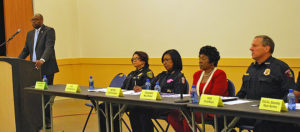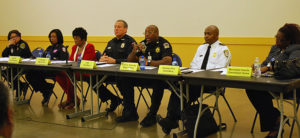Law enforcement agencies, local community groups, and citizens came together Tuesday, Oct. 11 at the Hiram Clark Multi-Service Center to discuss public safety issues.
Co-sponsored by the Five Corners Management District, Houston City Councilman Larry Green’s District K office, and the South Houston Concerned Citizens Coalition, the event drew about 100 attendees.
 As moderator, Green introduced the panel and presented questions crafted by community leaders first. He also offered statistics for District K showing a 5.9 percent overall drop in crime from September 2015 to the same month in 2016.
As moderator, Green introduced the panel and presented questions crafted by community leaders first. He also offered statistics for District K showing a 5.9 percent overall drop in crime from September 2015 to the same month in 2016.
Agencies represented on the panel included the Houston Police Department (HPD), Houston Fire Department (HFD), METRO Police, Houston Independent School District Police, S.E.A.L. Security Solutions, Harris County Constables Precinct 7, and City of Houston Municipal Courts.
HISD Police Chief Robert Mock assured the audience that “our first priority is to keep the kids safe.” That means the majority of their focus is on-campus, but officers have the authority to go off-campus to make arrests, break up fights, or address other problems that occur near the school, he said.
“These kids know their officers and the officers know their kids,” Mock added, emphasizing the importance of maintaining those relationships.
Gwendolyn Goins, public information officer for the Municipal Courts, talked about truancy issues and, specifically, the Juvenile Case Manager Program that puts a licensed social worker in the schools to work with students who are repeatedly truant and those at risk for truancy problems. Houston has the largest municipal court system in the state and the third largest in the nation by volume of cases, Goins added.
METRO Police Chief Vera Bumpers said her department covers 10,000 bus stops in 1,285 square miles and four counties.
“We do our best to cover the area wherever METRO goes,” she said.
HFD Chief Rodney West tried to answer why so many emergency vehicles often show up for calls regarding seniors and medical issues.
“The hardest thing to do is answer questions when you’re having an emergency,” he explained. Triage, which is the prioritizing of the caller’s needs by asking questions, is the only way to find out the level of response needed.
“Proper triage should give you the proper response,” he added.
 Many of the questions from the community involved traffic issues such as street racing, people running stop signs, bike lanes, school drop-off and pick-up traffic, and large commercial trucks tearing up neighborhood streets.
Many of the questions from the community involved traffic issues such as street racing, people running stop signs, bike lanes, school drop-off and pick-up traffic, and large commercial trucks tearing up neighborhood streets.
Constable May Walker addressed the truck question by advising that trucks weighing over a ton can be ticketed for a $1,000 fine if they violate areas marked with “No Through Trucks” signs.
Walker explained that constables are “the county’s police department,” covering 97.4 miles of patrol territory with a limited staff.
“We do what HPD does. We’re just a little smaller,” she said. “Some people call us both to see who gets there first.”
HPD Interim Police Chief Martha Montalvo responded to the question about street racing.
“We try to address those situations because they are a nuisance and they are dangerous,” she said.
Walker added to the chief’s answer by recommending that citizens try to capture a license plate number whenever possible. With regard to stop sign violations, Walker also said that a deputy can be dispatched to watch a specific location if there is a persistent problem.
 Reverend Ray Walker asked about police response times because a local business owner had reported a 45-minute wait before officers showed up in response to people shooting at the building. Montalvo explained that such a call would be designated a less urgent Code 2 if the offending parties had already left the location and no one was reported injured.
Reverend Ray Walker asked about police response times because a local business owner had reported a 45-minute wait before officers showed up in response to people shooting at the building. Montalvo explained that such a call would be designated a less urgent Code 2 if the offending parties had already left the location and no one was reported injured.
Another citizen asked about the response to a couple of homeless people living in a parked car in their neighborhood, coinciding with a rise in the number of break-ins in the neighborhood and a lot of debris left lying around the car. Police had responded to many calls, the questioner said, but told residents of the neighborhood there wasn’t much they could do as the couple drove away for short periods of time when asked to do so. They always returned, he added.
Montalvo conceded that the officers could have checked the car’s license plate number to determine who owned it and whether or not it was stolen.
“We should have responded better,” she added.






